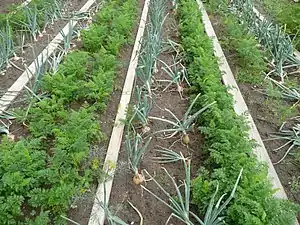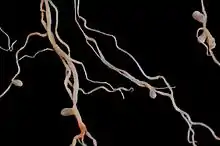Companion planting
Companion planting in gardening and agriculture is the planting of different crops in proximity for any of a number of different reasons, including pest control, pollination, providing habitat for beneficial insects, maximizing use of space, and to otherwise increase crop productivity. Companion planting is a form of polyculture.

Companion planting is used by farmers and gardeners in both industrialized and developing countries for many reasons. Many of the modern principles of companion planting were present many centuries ago in forest gardens in Asia, and thousands of years ago in Mesoamerica.
History
In China, mosquito ferns (Azolla spp.) have been used for at least a thousand years as companion plants for rice crops. They host a cyanobacterium (Anabaena azollae) that fixes nitrogen from the atmosphere, and they block light from plants that would compete with the rice.[2]
Companion planting was practiced in various forms by the indigenous peoples of the Americas prior to the arrival of Europeans. These peoples domesticated squash 8,000 to 10,000 years ago,[3][4] then maize, then common beans, forming the Three Sisters agricultural technique. The cornstalk served as a trellis for the beans to climb, the beans fixed nitrogen, benefitting the maize, and the wide leaves of the squash plant provide ample shade for the soil keeping it moist and fertile.[5][6][7]
Practice
More recently, starting in the 1920s, organic farming and horticulture have made frequent use of companion planting, since many other means of fertilizing, weed reduction and pest control are forbidden.[8] Permaculture advocates similar methods.[9]
The list of companion plants used in such systems is large, and includes vegetables, fruit trees, kitchen herbs, garden flowers, and fodder crops. The number of interactions both positive (the pair of species assist each other) and negative (the plants are best not grown together) is also large, though the evidence for such interactions ranges from controlled experiments to hearsay. For example, plants in the cabbage family (Brassicaceae) grow well with celery, onion family plants (Allium), and aromatic herbs, but are best not grown with strawberry or tomato.[10][11][12][13][14]
Mechanisms
Companion planting can operate through a variety of mechanisms, which may sometimes be combined. These include pest control, pollination, providing habitat for beneficial insects, and maximizing use of space; all of these may help to increase crop productivity.[15]
Nutrient provision

Legumes such as clover provide nitrogen compounds to neighbouring plants such as grasses by fixing nitrogen from the air with symbiotic bacteria in their root nodules. These enable the grasses or other neighbours to produce more protein and hence to grow more.[16][17][18][19]
Trap cropping
Trap cropping uses alternative plants to attract pests away from a main crop. For example, nasturtium (Tropaeolum majus) is a food plant of some caterpillars which feed primarily on members of the cabbage family (brassicas);[20] some gardeners claim that planting them around brassicas protects the food crops from damage, as eggs of the pests are preferentially laid on the nasturtium.[21] However, while many trap crops divert pests from focal crops in small scale greenhouse, garden and field experiments, only a small portion of these plants reduce pest damage at larger commercial scales.[22]
Host-finding disruption
Flying pests are far less successful if their host-plants are surrounded by other plants or even "decoy-plants" coloured green.[23] Pests find hosts in stages, first detecting plant odours which induce it to try to land on the host plant, avoiding bare soil. If the plant is isolated, then the insect simply lands on the patch of green near the odour, making an "appropriate landing". If it finds itself on the wrong plant, an "inappropriate landing", it takes off and flies to another plant; it eventually leaves the area if there are too many "inappropriate" landings.[23] Companion planting of clover as ground cover was equally disruptive to eight pest species from four different insect orders. In a test, 36% of cabbage root flies laid eggs beside cabbages growing in bare soil (destroying the crop), compared to only 7% beside cabbages growing in clover (which allowed a good crop). Simple decoys of green cardboard worked just as well as the live ground cover.[23]
Pest suppression
Some companion plants help prevent pest insects or pathogenic fungi from damaging the crop, through chemical means. For example, the smell of the foliage of marigolds is claimed to deter aphids from feeding on neighbouring plants.[24] A 2005 study found that oil volatiles extracted from Mexican marigold by vacuum distillation reduced the reproduction of three aphid species (pea aphid, green peach aphid and glasshouse and potato aphid) by up to 100% after 5 days from exposure.[25] Another example familiar to gardeners is the interaction of onions and carrots with each other's pests: the onion smell puts off carrot root fly, while the smell of carrots puts off onion fly.[1]
Predator recruitment
Companion plants that produce copious nectar or pollen in a vegetable garden (insectary plants) may help encourage higher populations of beneficial insects that control pests.[26]
Protective shelter

Some crops are grown under the protective shelter of different kinds of plant, whether as wind breaks or for shade. For example, shade-grown coffee, especially Coffea arabica, has traditionally been grown in light shade created by scattered trees with a thin canopy, allowing light through to the coffee bushes but protecting them from overheating.[27] Suitable Asian trees include Erythrina subumbrans (tton tong or dadap), Gliricidia sepium (khae falang), Cassia siamea (khi lek), Melia azedarach (khao dao sang), and Paulownia tomentosa, a useful timber tree.[28]
Approaches
Companion planting approaches in use or being trialled include:
- Square foot gardening attempts to protect plants from issues such as weed infestation by packing them as closely together as possible. This is facilitated by using companion plants, which can be closer together than normal.[29]
- Forest gardening, where companion plants are intermingled to simulate an ecosystem, emulates the interaction of plants of up to seven different heights in a woodland.[30]
See also
References
- "Companion Planting Guide". Thompson & Morgan. Archived from the original on 2 January 2018. Retrieved 14 June 2016.
- "Plant Resources for Human Development-Nitrogen in Rice" (PDF). Dhakai.com. p. 5. Archived from the original (PDF) on 4 March 2016. Retrieved 21 February 2015.
- Smith, B. D. (9 May 1997). "The initial domestication of Cucurbita pepo in the Americas 10,000 years ago" (PDF). Science. 276 (5314): 932–934. doi:10.1126/science.276.5314.932. Archived from the original (PDF) on 2020-07-28.
{{cite journal}}: CS1 maint: date and year (link) - "Cucurbitaceae--Fruits for Peons, Pilgrims, and Pharaohs". University of California at Los Angeles. Archived from the original on 16 October 2013. Retrieved 2 September 2013.
- Mount Pleasant, Jane (2006). "The science behind the Three Sisters mound system: An agronomic assessment of an indigenous agricultural system in the northeast". In Staller, John E.; Tykot, Robert H.; Benz, Bruce F. (eds.). Histories of Maize: Multidisciplinary Approaches to the Prehistory, Linguistics, Biogeography, Domestication, and Evolution of Maize. Amsterdam: Academic Press. pp. 529–537. ISBN 978-1-5987-4496-5.
- Landon, Amanda J. (2008). "The 'How' of the Three Sisters: The Origins of Agriculture in Mesoamerica and the Human Niche". Nebraska Anthropologist. 23: 110–124. ISSN 1555-4937. Archived from the original on 2021-08-29. Retrieved 2021-08-30.
- Bushnell, G. H. S. (1976). "The Beginning and Growth of Agriculture in Mexico". Philosophical Transactions of the Royal Society of London. 275 (936): 117–120. Bibcode:1976RSPTB.275..117B. doi:10.1098/rstb.1976.0074.
- "5 Secrets to Vegetable Garden, Companion Planting Revealed". Organic Authority. 22 October 2018. Archived from the original on 1 May 2019. Retrieved 1 May 2019.
- Ludwig-Cooper, Stephanie (2 December 2011). "Companion Planting Information and Chart". Permaculture News. Retrieved 18 October 2023.
- "Cornell University Cooperative Extension - Companion Planting" (PDF). Archived from the original (PDF) on 21 February 2014. Retrieved 3 January 2021.
- "Companion Plants". Alabama Cooperative Extension System. Archived from the original on 30 April 2015. Retrieved 3 January 2021.
- Riotti, Louise (2004). Carrots love tomatoes & roses love garlic: Secrets of companion planting for successful gardening. Storey Publishing. Chapter 1: Vegetables; Chapter 2: Herbs.
- Riesselman, Leah. Companion planting: A method for sustainable pest control (PDF) (Technical report). Iowa State University. RFR-A9099. Archived from the original (PDF) on 2013-05-14. Retrieved 2014-03-22.
- Nardozzi, Charlie (2010). "Companion and Interplanting". National Gardening Association. Archived from the original on 7 October 2016. Retrieved 3 January 2021.
- McClure, Susan (1995). "Companion Planting Made Easy" (PDF). Hpfb.org. pp. 4–6. Retrieved 9 February 2022. excerpted from McClure, Susan (1994). Companion Planting. Rodale Press. ISBN 978-0-87596-616-8.
- Wagner, S. C. (2011). "Biological Nitrogen Fixation". Nature Education Knowledge. 3 (10): 15. Archived from the original on 2018-09-13. Retrieved 2019-05-01.
- Wang, Qi; Yang, Shengming (2017). "Host-secreted antimicrobial peptide enforces symbiotic selectivity in Medicago truncatula". PNAS. 114 (26): 6854–6859. Bibcode:2017PNAS..114.6854W. doi:10.1073/pnas.1700715114. PMC 5495241. PMID 28607058.
- Postgate, J. (1998). Nitrogen Fixation. Cambridge University Press. Chapter 1: The nitrogen cycle; Chapter 3: Physiology; Chapter 4: The free-living microbes.
- Smil, Vaclav (2000). Cycles of Life. Scientific American Library. Chapter: Reactive nitrogen in the biosphere. ISBN 978-0716760399.
- "Cabbage caterpillars". Royal Horticultural Society. Archived from the original on 25 February 2013. Retrieved 10 February 2013.
- Pleasant, Barbara (June–July 2011). "Organic Pest Control: What Works, What Doesn't". Mother Earth News (246): 36–41.
- Holden, Matthew H.; Ellner, Stephen P.; Lee, Doo-Hyung; Nyrop, Jan P.; Sanderson, John P. (2012-06-01). "Designing an effective trap cropping strategy: the effects of attraction, retention and plant spatial distribution". Journal of Applied Ecology. 49 (3): 715–722. doi:10.1111/j.1365-2664.2012.02137.x.
- Finch, S.; Collier, R. H. (2003). "Insects can see clearly now the weeds have gone" (PDF). Biologist. 50 (3): 132–135. Archived (PDF) from the original on 2020-08-01. Retrieved 2011-09-15.
- Pleasant, Barbara (22 January 2013). "Attract Hoverflies for Organic Aphid Control". Mother Earth News. Archived from the original on 1 August 2020. Retrieved 3 January 2022.
- Tomova, Blagovesta S.; Waterhouse, John S.; Doberski, Julian (2005). "The effect of fractionated Tagetes oil volatiles on aphid reproduction". Entomologia Experimentalis et Applicata. 115 (1): 153–159. doi:10.1111/j.1570-7458.2005.00291.x. ISSN 1570-7458. S2CID 86565848.
- "Pacific Northwest Nursery IPM. Flowers, Sweets and a Nice Place to Stay: Courting Beneficials to Your Nursery". Oregon State University. Archived from the original on 17 April 2014. Retrieved 11 February 2013.
- Rice, Robert (2010). "The Ecological Benefits of Shade-Grown Coffee: The Case for Going Bird Friendly". Smithsonian. Archived from the original on 2019-05-01. Retrieved 2019-05-01.
- Winston, Edward; Op de Laak, Jacques; Marsh, Tony; Lempke, Herbert; Chapman, Keith. "Arabica Coffee Manual for Lao-PDR: Chapter 3 Field Management & Planting Trees". Food and Agriculture Organization. Archived from the original on 1 May 2019. Retrieved 1 May 2019.
- Bartholomew, Mel (2013). All New Square Foot Gardening (2nd ed.). Cool Springs Press. ISBN 978-1591865483.
- McConnell, Douglas John (1992). The Forest-Garden Farms of Kandy, Sri Lanka. p. 1. ISBN 978-9251028988. Archived from the original on 2021-08-09. Retrieved 2020-11-26.. See also McConnell, Douglas John (1973). The economic structure of Kandyan forest-garden farms. OCLC 5776386.